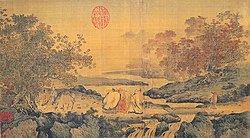Three laughs at Tiger Brook
This article does not cite any sources. (June 2021) |

Three laughs at Tiger Brook (Chinese: 虎溪三笑; Pinyin: hǔ xī sān xiào; Gan: fû ki sam siēu) is a Chinese proverb which refers to the image that the three men, Huiyuan, Tao Yuanming and Lu Xiujing laugh together when arriving at Huxi (虎溪, Tiger Brook) of Mount Lu. This concept represents the ideal harmonious relations of Confucianism, Taoism and Buddhism in ancient China.
Origin[]
The proverb derives from the story of the retired civil servant and Buddhist monk Huiyuan (334–416), who used never to go farther than the Huxi, either for a solitary walk or a friend's visit. Moreover, the tiger in its forest would roar, warning him whenever he had crossed the brook and entered its territory. One day, however, on the visit of the Confuscian poet Tao Yuanming (365–427) and Taoist Lu Xiujing (406–477), Huiyuan had a congenial talk with them. So engrossing indeed was their conversation that they only realized they had passed the brook when they heard the roar of the tiger, whereupon the sages laughed wisely together.
Thus was the concord primary of the three main Chinese religions/philosophies of that time, namely Buddhism, Confucianism, and Taoism illustrated. The story began as early as the Tang dynasty and became popular during the Song. It presents an inachronistic event inasmuch as Lu Xiujing would have been at most about 10 years old when Huiyan died, however.
References[]
External links[]
- Chinese words and phrases
- Three teachings
- Chinese philosophy stubs